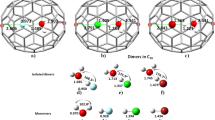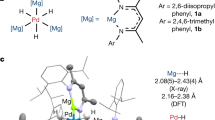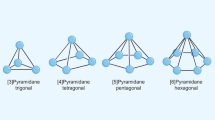Abstract
Carbon centres in typical organic molecules have a coordination number that can reach a maximum of four, in which case the bonded atoms are situated at the vertices of a tetrahedron. Exceptions to those two structural rules have been posited and examined for decades, and planar tetracoordinate carbon (ptC) species are notable molecules that violate the second rule. There is continued interest in experimental and theoretical studies of ptCs, as well as emerging molecules that contain planar pentacoordinate carbon (ppC) and planar hexacoordinate carbon (phC) atoms, species that violate both structural rules. This Review describes recent progress in the theoretical prediction of viable entities that contain ppC centres. The first such molecule reported, the D5h-symmetric ppC species CAl5+, was followed by a series of predicted ppC species that could be obtained by substituting the Al centres for other heteroatoms. More complicated ppC systems have also been suggested, including metallocene-stabilized ppCs and quasi-ppCs embedded within cage structures or 2D materials. To date, computational studies have identified at least 65 local and 39 global minimum energy structures that contain ppCs or quasi-ppCs. The general design principles for ptC-centred candidate structures include delocalization of the central C 2pz lone electron pair, ensuring an 18 valence electron count and allowing for strong electron delocalization. These principles have been extended to ppC systems with some success. It is hard to predict the extent to which the coordination number of planar C can be increased because it depends not only on the valence and size of C but also on the size of the atoms bonded to it and the mode of bonding. Although a few energetically low-lying planar hexacoordinate and heptacoordinate C species have been identified computationally, none have been observed experimentally.
This is a preview of subscription content, access via your institution
Access options
Access Nature and 54 other Nature Portfolio journals
Get Nature+, our best-value online-access subscription
$29.99 / 30 days
cancel any time
Subscribe to this journal
Receive 12 digital issues and online access to articles
$119.00 per year
only $9.92 per issue
Buy this article
- Purchase on Springer Link
- Instant access to full article PDF
Prices may be subject to local taxes which are calculated during checkout








Similar content being viewed by others
References
Tal’roze, V. L. & Ljubimova, A. K. Secondary processes in the ion source of a mass spectrometer. J. Mass Spectrom. 33, 502–504 (1998).
Bartlett, P. D. Nonclassical Ions (WA Benjamin, New York, 1965).
Brown, H. C. The Nonclassical-Ion Problem (Plenum, New York, 1977).
Olah, G. A., Prakash, G. K. S. & Saunders, M. Conclusion of the classical–nonclassical ion controversy based on the structural study of the 2-norbornyl cation. Acc. Chem. Res. 16, 440–448 (1983).
Minkin, V. I., Minyaev, R. M. & Hoffmann, R. Nonclassical structures of organic compounds: non-standard stereochemistry and hypercoordination. Russ. Chem. Rev. 71, 869–892 (2002).
Olah, G. A. My search for carbocations and their role in chemistry (Nobel lecture). Angew. Chem. Int. Ed. 34, 1393–1405 (1995).
Monkhorst, H. J. Activation energy for interconversion of enantiomers containing an asymmetric carbon atom without breaking bonds. Chem. Commun. 1111–1112 (1968).
Hoffmann, R., Alder, R. W. & Wilcox, C. F. Planar tetracoordinate carbon. J. Am. Chem. Soc. 92, 4992–4993 (1970).
Pepper, M. J. M. et al. Is the stereomutation of methane possible? J. Comput. Chem. 16, 207–225 (1995).
Gordon, M. S. & Schmidt, M. W. Does methane invert through square planar? J. Am. Chem. Soc. 115, 7486–7492 (1993).
Sorger, K. & Schleyer, P. v. R. Planar and inherently non-tetrahedral tetracoordinate carbon: a status report. J. Mol. Struct. 338, 317–346 (1995).
Keese, R. Carbon flatland: planar tetracoordinate carbon and fenestranes. Chem. Rev. 106, 4787–4808 (2006).
Collins, J. B. et al. Stabilization of planar tetracoordinate carbon. J. Am. Chem. Soc. 98, 5419–5427 (1976).
Cotton, F. A. & Millar, M. The probable existence of a triple bond between two vanadium atoms. J. Am. Chem. Soc. 99, 7886–7891 (1977).
Schleyer, P. v. R. & Boldyrev, A. I. A new, general strategy for achieving planar tetracoordinate geometries for carbon and other second row periodic elements. J. Chem. Soc., Chem. Commun. 1536–1538 (1991).
Boldyrev, A. I. & Simons, J. Tetracoordinated planar carbon in pentaatomic molecules. J. Am. Chem. Soc. 120, 7967–7972 (1998).
Cui, Z.-H., Shao, C.-B., Gao, S.-M. & Ding, Y.-H. Pentaatomic planar tetracoordinate carbon molecules [XCAl3]q [(X. q) = (B, −2), (C, −1), (N, 0)] with C–X multiple bonding. Phys. Chem. Chem. Phys. 12, 13637–13645 (2010).
Castro, A. C. et al. Planar tetracoordinate carbon in CE42− (E = Al–Ti) clusters. Chem. Phys. Lett. 519–520, 29–33 (2012).
Cui, Z.-H. et al. Planar tetracoordinate carbons with a double bond in CAl3E clusters. Phys. Chem. Chem. Phys. 17, 8769–8775 (2015).
Li, X., Wang, L.-S., Boldyrev, A. I. & Simons, J. Tetracoordinated planar carbon in the Al4C− anion. A combined photoelectron spectroscopy and ab initio study. J. Am. Chem. Soc. 121, 6033–6038 (1999).
Wang, L.-S., Boldyrev, A. I., Li, X. & Simons, J. Experimental observation of pentaatomic tetracoordinate planar carbon-containing molecules. J. Am. Chem. Soc. 122, 7681–7687 (2000).
Albrecht, M., Erker, G. & Kruger, C. The synthesis of stable, isolable planar-tetracoordinate carbon compounds. Synlett 441–448 (1993).
Evans, W. J., Keyer, R. A. & Ziller, J. W. Investigation of organolanthanide-based carbon–carbon bond formation: synthesis, structure, and coupling reactivity of organolanthanide alkynide complexes, including the unusual structures of the trienediyl complex [(C5Me5)2Sm]2[μ-η2:η2-Ph(CH2)2C=C=C=C-(CH2)2Ph] and the unsolvated alkynide [(C5Me5)2Sm(C≡CCMe3)]2 . Organometallics 12, 2618–2633 (1993).
Rö ttger, D. & Erker, G. Compounds containing planar-tetracoordinate carbon. Angew. Chem. Int. Ed. 36, 812–827 (1997).
Choukroun, R. & Cassoux, P. Planar tetracoordination of carbon in groups 4 and 5 organometallic chemistry. Acc. Chem. Res. 32, 494–502 (1999).
Choukroun, R. & Lorber, C. Adventures in vanadocene chemistry. Eur. J. Inorg. Chem. 4683–4692 (2005).
Su, M.-D. Theoretical designs for planar tetracoordinated carbon in Cu, Ag, and Au organometallic chemistry: a new target for synthesis. Inorg. Chem. 44, 4829–4833 (2005).
Suresh, C. H. & Frenking, G. Direct 1–3 metal–carbon bonding and planar tetracoordinated carbon in group 6 metallacyclobutadienes. Organometallics 29, 4766–4769 (2010).
Jia, X. F. & Zhang, C. J. Structure, bonding and reactivity of coinage metal complexes TML2 and TML2+ (TM = Cu, Ag, Au) with planar tetracoordinate carbon, a theoretical investigation. Comput. Theor. Chem. 1075, 47–53 (2016).
Merino, G., Mendez-Rojas, M. A. & Vela, A. (C5M2−n)n− (M = Li, Na, K, and n = 0, 1, 2). A new family of molecules containing planar tetracoordinate carbons. J. Am. Chem. Soc. 125, 6026–6027 (2003).
Pérez-Peralta, N. et al. Stabilizing carbon–lithium stars. Phys. Chem. Chem. Phys. 13, 12975–12980 (2011).
Perez, N. et al. Planar tetracoordinate carbons in cyclic hydrocarbons. Org. Lett. 7, 1509–1512 (2005).
Merino, G., Méndez-Rojas, M. A., Vela, A. & Heine, T. Recent advances in planar tetracoordinate carbon chemistry. J. Comput. Chem. 28, 362–372 (2007).
Perez-Peralta, N. et al. Planar tetracoordinate carbons in cyclic semisaturated hydrocarbons. J. Org. Chem. 73, 7037–7044 (2008).
Cui, Z.-H., Contreras, M., Ding, Y.-H. & Merino, G. Planar tetracoordinate carbon versus planar tetracoordinate boron: the case of CB4 and its cation. J. Am. Chem. Soc. 133, 13228–13231 (2011).
Wu, Y.-B. et al. Starlike aluminum–carbon aromatic species. Chem. Eur. J. 17, 714–719 (2011).
Crigger, C., Wittmaack, B. K., Tawfik, M., Merino, G. & Donald, K. J. Plane and simple: planar tetracoordinate carbon centers in small molecules. Phys. Chem. Chem. Phys. 14, 14775–14783 (2012).
Pan, S. et al. C5Li7+ and O2Li5+ as noble-gas-trapping agents. Chem. Eur. J. 19, 2322–2329 (2013).
Bomble, L., Steinmann, S., Perez-Peralta, N., Merino, G. & Corminboeuf, C. Bonding analysis of planar hypercoordinate atoms via the generalized BLW-LOL analysis. J. Comput. Chem. 34, 2242–2248 (2013).
Bolton, E. E., Laidig, W. D., Schleyer, P. v. R. & Schaefer, H. F. Does singlet 1,1-dilithioethene really prefer a perpendicular structure? J. Phys. Chem. 99, 17551–17557 (1995).
Wang, Z.-X. & Schleyer, P. v. R. Construction principles of “hyparenes”: families of molecules with planar pentacoordinate carbons. Science 292, 2465–2469 (2001).
Wang, Z.-X. & Schleyer, P. v. R. Planar hypercoordinate carbons joined: wheel-shaped molecules with C–C axles. Angew. Chem. Int. Ed. 41, 4082–4085 (2002).
Li, S.-D., Miao, C.-Q. & Ren, G.-M. D5 Cu5H5X: pentagonal hydrocopper Cu5H5 containing pentacoordinate planar nonmetal centers (X = B, C, N, O). Eur. J. Inorg. Chem. 2232–2234 (2004).
Li, S.-D., Guo, Q.-L., Miao, C.-Q. & Ren, G.-M. Investigation on transition-metal hydrometal complexes MnHnC with planar coordinate carbon centers by density functional theory. Acta Phys. Chim. Sin. 23, 743–745 (2007).
Erhardt, S., Frenking, G. & Chen, Z. F. & Schleyer, P. v. R. Aromatic boron wheels with more than one carbon atom in the center: C2B8, C3B93+, and C5B11+. Angew. Chem. Int. Ed. 44, 1078–1082 (2005).
Luo, Q. Theoretical observation of hexaatomic molecules containing pentacoordinate planar carbon. Sci. China Ser. B Chem. 51, 1030–1035 (2008).
Pei, Y., An, W., Ito, K., Schleyer, P. v. R. & Zeng, X. C. Planar pentacoordinate carbon in CAl5+: a global minimum. J. Am. Chem. Soc. 130, 10394–10400 (2008).
Pei, Y. & Zeng, X. C. Probing the planar tetra-, penta-, and hexacoordinate carbon in carbon–boron mixed clusters. J. Am. Chem. Soc. 130, 2580–2592 (2008).
Averkiev, B. B. et al. Carbon avoids hypercoordination in CB6−, CB62−, and C2B5− planar carbon–boron clusters. J. Am. Chem. Soc. 130, 9248–9250 (2008).
Liang, J.-X., Jia, W.-H., Zhang, C.-J. & Cao, Z.-X. Unusual boron–carbon compounds containing planar tetracoordinate and pentacoordinate carbons. Acta Phys. Chim. Sin. 25, 1847–1852 (2009).
Zdetsis, A. D. Success and pitfalls of the Sin − 2C2H2–C2Bn−2Hn isolobal analogy: depth and breadth of the boron connection. J. Chem. Phys. 130, 064303 (2009).
Zdetsis, A. D. Novel pentagonal silicon rings and nanowheels stabilized by flat pentacoordinate carbon(s). J. Chem. Phys. 134, 094312 (2011).
Yamaguchi, W. δ and σ versus π conflicting aromatic pentagonal ring of tungsten with a planar pentacoordinate carbon at the ring center. Int. J. Quantum Chem. 110, 1086–1091 (2010).
Merino, G. & Solà, M. Celebrating the 150th anniversary of the Kekulé benzene structure. Phys. Chem. Chem. Phys. 18, 11587–11588 (2016).
Hoffmann, R. The many guises of aromaticity. Am. Sci. 103, 18 (2015).
Li, X., Kuznetsov, A. E., Zhang, H.-F., Boldyrev, A. I. & Wang, L.-S. Observation of all-metal aromatic molecules. Science 291, 859–861 (2001).
Kuznetsov, A. E. et al. All-metal antiaromatic molecule: rectangular Al44− in the Li3Al4− anion. Science 300, 622–625 (2003).
Islas, R., Heine, T. & Merino, G. Structure and electron delocalization in Al42− and Al44−. J. Chem. Theory Comput. 3, 775–781 (2007).
Jimenez-Halla, J. O. C. et al. CAl4Be and CAl3Be2−: global minima with a planar pentacoordinate carbon atom. Chem. Commun. 46, 8776–8778 (2010).
Castro, A. C. et al. CBe5E− (E = Al, Ga, In, Tl): planar pentacoordinate carbon in heptaatomic clusters. Phys. Chem. Chem. Phys. 14, 14764–14768 (2012).
Wu, Y.-B., Duan, Y., Lu, H.-G. & Li, S.-D. CAl2Be32− and its salt complex LiCAl2Be3−: anionic global minima with planar pentacoordinate carbon. J. Phys. Chem. A 116, 3290–3294 (2012).
Zhang, X.-Y. & Ding, Y.-H. CAl4Ga+. Comput. Theor. Chem. 1048, 18–24 (2014).
Grande-Aztatzi, R. et al. Planar pentacoordinate carbons in CBe54− derivatives. Phys. Chem. Chem. Phys. 17, 4620–4624 (2015).
Guo, J.-C. et al. CBe5Hnn−4 (n = 2–5): hydrogen-stabilized CBe5 pentagons containing planar or quasi-planar pentacoordinate carbons. J. Phys. Chem. A 119, 13101–13106 (2015).
Guo, J.-C. et al. Star-like superalkali cations featuring planar pentacoordinate carbon. J. Chem. Phys. 144, 244303 (2016).
Cui, Z.-H., Sui, J.-J. & Ding, Y.-H. How can carbon favor planar multi-coordination in boron-based clusters? Global structures of CBxEy2− (E = Al, Ga. x + y = 4). Phys. Chem. Chem. Phys. 17, 32016–32022 (2015).
Hou, J. H. et al. Exploring the geometrical structures of X©BnHnm [(X. m) = (B, +1), (C, +2) for n = 5; (X, m) = (Be, 0), (B, +1) for n = 6] by an electronic method. New J. Chem. 39, 8630–8637 (2015).
Gribanova, T. N., Minyaev, R. M. & Minkin, V. I. Structure and stability of the C-doped boron fullerenes B60C12 and B80C12 with quasi-planar pentacoordinated cage carbon atoms: a quantum-chemical study. Mendeleev Commun. 26, 485–487 (2016).
Wang, Y., Li, F., Li, Y. F. & Chen, Z. F. Semi-metallic Be5C2 monolayer global minimum with quasi-planar pentacoordinate carbons and negative Poisson's ratio. Nat. Commun. 7, 11488 (2016).
Li, J.-J. et al. Zigzag double-chain C–Be nanoribbon featuring planar pentacoordinate carbons and ribbon aromaticity. J. Mater. Chem. C 5, 408–414 (2017).
Cui, Z.-H. et al. Planar pentacoordinate carbon atoms embedded in a metallocene framework. Chem. Commun. 53, 138–141 (2017).
Exner, K. & Schleyer, P. v. R. Planar hexacoordinate carbon: a viable possibility. Science 290, 1937–1940 (2000).
Islas, R., Heine, T., Ito, K., Schleyer, P. v. R. & Merino, G. Boron rings enclosing planar hypercoordinate group 14 elements. J. Am. Chem. Soc. 129, 14767–14774 (2007).
Wang, L.-M., Huang, W., Averkiev, B. B., Boldyrev, A. I. & Wang, L.-S. CB7−: experimental and theoretical evidence against hypercoordinate planar carbon. Angew. Chem. Int. Ed. 46, 4550–4553 (2007).
Wu, Y.-B. et al. D3h CN3Be3+ and CO3Li3+: viable planar hexacoordinate carbon prototypes. Phys. Chem. Chem. Phys. 14, 14760–14763 (2012).
Zhang, C.-F., Han, S.-J., Wu, Y.-B., Lu, H.-G. & Lu, G. Thermodynamic stability versus kinetic stability: is the planar hexacoordiante carbon species D3h CN3Mg3+ viable? J. Phys. Chem. A 118, 3319–3325 (2014).
Li, Y., Liao, Y. & Chen, Z. Be2C monolayer with quasi-planar hexacoordinate carbons: a global minimum structure. Angew. Chem. Int. Ed. 53, 7248–7252 (2014).
Heine, T. & Merino, G. What is the maximum coordination number in a planar structure? Angew. Chem. Int. Ed. 51, 4275–4276 (2012).
Zhao, T., Wang, Q. & Jena, P. Cluster-inspired design of high-capacity anode for Li-ion batteries. ACS Energy Lett. 1, 202–208 (2016).
Dai, J., Wu, X., Yang, J. & Zeng, X. C. AlxC monolayer sheets: two-dimensional networks with planar tetracoordinate carbon and potential applications as donor material in solar cell. J. Phys. Chem. Lett. 5, 2058–2065 (2014).
Acknowledgements
The authors acknowledge the generous support from Conacyt (Grand CB-2015-252356). V.V.-G. thanks Conacyt for the awarding of a fellowship. K.J.D. was supported in Richmond by the National Science Foundation (NSF-CAREER Award CHE-1056430 and the Henry Dreyfus Teacher-Scholar Awards Program. S.P. thanks Nanjing Tech University for his postdoctoral fellowship.
Author information
Authors and Affiliations
Contributions
All authors contributed equally to the preparation of this manuscript.
Corresponding author
Ethics declarations
Competing interests
The authors declare no competing interests.
Rights and permissions
About this article
Cite this article
Vassilev-Galindo, V., Pan, S., Donald, K. et al. Planar pentacoordinate carbons. Nat Rev Chem 2, 0114 (2018). https://doi.org/10.1038/s41570-018-0114
Published:
DOI: https://doi.org/10.1038/s41570-018-0114
This article is cited by
-
Planar Octacoordinate Aluminium in Dual Aromatic AlBe4N4− Cluster
Journal of Cluster Science (2023)
-
σ-Aromaticity in planar pentacoordinate aluminium and gallium clusters
Scientific Reports (2022)
-
Ternary CE2Ba2 (E = As, Sb) Clusters: New Pentaatomic Planar Tetracoordinate Carbon Species with 18 Valence Electrons
Journal of Molecular Modeling (2022)
-
BSinGe4−n+ (n = 0−2): prospective systems containing planar tetracoordinate boron (ptB)
Journal of Chemical Sciences (2022)
-
Evaluation of restricted probabilistic cellular automata on the exploration of the potential energy surface of Be6B11−
Theoretical Chemistry Accounts (2020)



